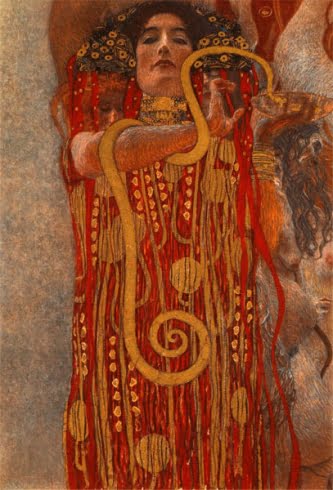Hygeia, Goddess of Health
Hygeia was the Greek goddess of health, cleanliness, and sanitation.

- Pantheon: Greek Pantheon
- Deity Title: Hygeia, Goddess of Health
- Deity Symbol: A serpent drinking from a cup
- Home Plane: Olympian plane
- Deity Level: Lesser deity
- Alignment: Neutral Good
- Aliases: None
- Superior: None
- Traditional Allies: Apollo, Asclepius (Father), Athena, and the other healing deities
- Traditional Foes: Pestilence deities such as Akhlut, Apep, and Nefertum
- Divine Artifact: The Cup of Hygeia, a magical chalice that can cure any disease or ailment
- Servants: Angels and other celestial beings that serve as messengers and healers
- Servitor Creatures: None
- Sacred Animal: Snakes, particularly those that shed their skin, symbolizing the renewal of health
- Manifestations: Appearances in dreams, visions, and healing miracles, as well as blessings of good health
- Signs of Favor: Healing miracles and the spread of good health
- Worshipers: Healers, physicians, nurses, and other medical professionals, as well as those seeking good health and well-being
- Cleric Alignments: Neutral Good, Lawful Good, Chaotic Good
- Specialty Priests: Physicians, herbalists, and healers
- Holy Days: The Festival of Hygeia, held annually on the first day of spring, as well as various feast days throughout the year
- Portfolio: Health, healing, and well-being
- Domains: Life, Light, and Nature
- Favored Weapon: None
- Favored Class: Cleric
- Favored Race: Humans and other mortal races
- Duties of the Priesthood: To tend to the sick and injured, administer healing spells and potions, and promote good health and hygiene
- Major Cult/Temple Sites: The Temple of Hygeia in Athens, as well as various healing sanctuaries throughout Greece
- Benefits: The ability to cast healing spells, immunity to diseases, and the favor of the goddess in matters of health and healing.
Hygeia, the Greek goddess of health, radiates an aura of purity and cleanliness. She appears as a youthful woman with a serene expression and a lithe, graceful figure. Her skin is soft and unblemished, with a rosy glow that speaks of perfect health. Her wavy golden hair cascades down her back like a waterfall of sunlight, framing her heart-shaped face with delicate tendrils.
Hygeia’s attire is simple but elegant, consisting of a flowing white robe that falls in gentle folds around her body. The fabric seems to shimmer with a faint light that emanates from her, casting a soft glow on everything around her. She wears a wreath of laurel on her head, symbolizing her connection to healing and medicine, and carries a staff entwined with a snake, the ancient symbol of medicine.
As the goddess of health, Hygeia’s mission is to promote physical, mental, and spiritual well-being among mortals. She watches over those who seek her aid, offering comfort and guidance to those who are sick or injured. She is also a patron of doctors, healers, and all those who practice the art of medicine. Her powers extend beyond the realm of the body, as she also has the ability to soothe troubled minds and heal emotional wounds.
Hygeia’s ultimate goal is to ensure that all mortals live healthy and fulfilling lives, free from pain and suffering. She believes that the key to achieving this is through prevention, encouraging mortals to take care of their bodies and minds before illness or injury strikes. Hygeia also believes in the power of community, promoting healthy relationships and social connections as a means of improving overall well-being.
Despite her gentle demeanor, Hygeia is a formidable goddess, capable of unleashing powerful healing magic when needed. She is a source of hope and inspiration for mortals, reminding them that even in times of sickness and hardship, there is always the possibility of healing and renewal.
Currently in the World
Hygeia, the goddess of health, has always been deeply invested in the well-being of mortals. From the moment she was created, she took it upon herself to watch over humanity, to ensure that they remained healthy and strong.
In the 1450s, Hygeia is focused on the rise of the bubonic plague in Europe. She is distraught by the suffering it has caused and has been tirelessly working to find a solution. She spends her days consulting with healers and physicians, searching for a cure that will save countless lives.
Despite her efforts, the disease continues to spread, and Hygeia feels helpless in the face of its relentless advance. She watches with sadness as families are torn apart, and entire communities are decimated by the plague.
But Hygeia is not one to give up easily. She refuses to let the disease win, and so she turns her attention to the source of the plague: the rats that carry the fleas that spread the disease. She calls upon her powers and sends a swarm of rats to a remote island, far from human civilization. There, she hopes to isolate the disease and prevent its spread.
But even as she works to contain the disease, Hygeia knows that she must do more. She turns her attention to the humans who have been infected and to the healers who are trying to save them. She blesses them with her divine powers, giving them the strength and the knowledge they need to fight the disease.
Hygeia knows that the battle against the plague will be long and difficult, but she remains steadfast in her resolve. She is determined to save as many lives as she can, and to ensure that humanity remains healthy and strong.
As the years pass, Hygeia continues to work tirelessly to keep humanity healthy. She is revered by healers and physicians all over the world, and her name is spoken with reverence by those who know of her deeds. Despite the many challenges she has faced, Hygeia remains determined to protect humanity, to ensure that they thrive and flourish for generations to come.

 Buy me a coffee
Buy me a coffee